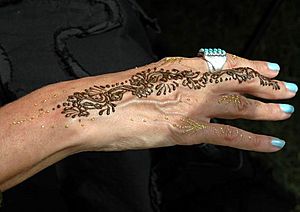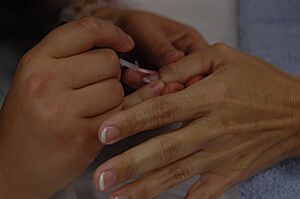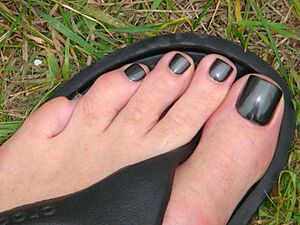Nail art facts for kids
Nail art is a fun and creative way to decorate your fingernails and toenails. It's like drawing tiny pictures or designs right on your nails! Many people today see their nails as an important part of their overall look and beauty.
Nail art is also a big part of fashion. It's closely related to manicures, which are treatments to make your hands and nails look great. You can find special shops called 'nail bars' where experts help make nails look amazing. One popular option is using acrylic nails with cool designs that can be glued over your natural nails.
Contents
Nail Polish: Colors and Protection
Nail polish, also known as nail varnish, is a special liquid applied to your fingernails or toenails. It's used to make them look pretty and to help protect them. Most modern nail polishes are made from a material called nitrocellulose mixed with a solvent like butyl acetate.
Nail polish can be clear or come in many different colors thanks to pigments. It also has special ingredients called plasticizers, like camphor. These make the polish flexible when it dries. This flexibility helps the polish resist cracking or flaking as your nails naturally move.
The History of Nail Polish
People have been decorating their nails for thousands of years! In ancient China, nail polish was first made from things like beeswax, egg whites, gelatin, plant dyes, and rose petals. People would dip their hands in this mix until their nails turned red or pink.
In Ancient Egypt, henna was used to stain fingernails orange. This color would then change to dark red or brown. Around 1300 BC, the color of nail polish showed a person's social rank. Gold and silver were popular colors, and later, black and red became favorites. The famous Egyptian queen Cleopatra was known for wearing red nail polish.
By the 9th century, people started using scented red oils on their nails. They would then polish them with a soft cloth instead of just painting them. In the 19th and early 20th centuries, people preferred a shiny, natural look. They would rub tinted powders and creams into their nails and then buff them until they shined.
The first modern nail polish was created in 1917 by a company called Cutex. This happened after automobile paint was invented. Synthetic nail polish, similar to what we use today, was first introduced in Paris in the 1920s.
Artificial Nails: Extensions for Beauty
Artificial nails aren't meant to replace your natural nails. Instead, they are extensions that make your nails longer or stronger. There are two main ways to create artificial nails: using tips or forms.
- Tips are lightweight plastic pieces shaped like nails. They are glued onto the end of your natural nail. Then, a liquid acrylic material is applied over your entire nail to create a smooth finish.
- Forms are fitted around your nail. An artificial nail is then molded from acrylic directly onto your nail using the form. Once the new nail hardens, the form is removed, and the new nail is shaped and buffed to a shine.
Acrylic Nails
Acrylic nails are made from a mix of a powder and a liquid. This mixture starts to get hard very quickly, usually within 30 to 40 seconds after it's applied. It reaches its full hardness in about fifteen minutes. Acrylic nails can be removed using special solvents, most often acetone. It usually takes about 15 to 20 minutes to soak off the nail.
UV Top Coat
Another material used for nails is called "UV Top Coat." This is a type of polymer resin that hardens when exposed to ultraviolet light. These coatings can have different qualities, like being very flexible or very strong. They might be a bit more expensive than acrylics. Unlike acrylics, UV top coats cannot be removed with solvents; they must be filed off or allowed to grow out with your natural nail.
Other Nail Options
Besides acrylic or gel, other popular options include fiberglass or silk wraps. These are made by cutting small pieces of fiberglass or silk fabric to fit your nail. The fabric is then sealed onto the nail with a special resin or glue. These wraps are a good choice for people who might be allergic to the chemicals used in acrylic or gel processes.
You can also find temporary, cheaper nail tips that you can quickly glue on at home without needing a professional. Acrylic nail powders come in many colors and can have cool "special effects." These include sparkles or the very popular French manicure, which gives nails a classic pink and white look.
Nails for Guitar Players
Some guitar players use their nails to pluck the strings instead of using their fingertips or a 'pick' (a small piece of metal or plastic). If they use their nails, these nails must be in perfect condition and kept at the exact same length all the time. Some guitarists might even use acrylic stick-on nails to help them play. Every guitarist has their own preferred way of playing.
Players of many old Chinese instruments, like the guqin, pipa, and ruan, also often used artificial nails to help them play.
Related pages
Images for kids
-
Nail art depicting the video game Pacman
See also
 In Spanish: Estética de uñas para niños
In Spanish: Estética de uñas para niños












